Take Care of Your Brand Sentiment and Win The Market by 2026
Table of contents
Urban Outfitters is a clothing brand that evokes mostly positive customer sentiments. However, on November 11, the brand’s negative mentions increased by over 300%! This was correlated with the Singles Day vinyl release featuring exclusive tracks from famous artists.
What put Urban Outfitters’s customers in a bad mood?
Let’s conduct a brand sentiment analysis and find out together!
Brand sentiment refers to consumers’ overall emotional tone and attitude towards a brand. Based on opinions, reviews, and social media conversations, it reflects whether public perception is generally positive, negative, or neutral. Measuring brand sentiment helps companies understand how their brand is viewed by the public and guides marketing strategies for reputation management.
Monitoring and understanding brand sentiment is key to your brand’s success.
Customers will be more willing to buy your products when your brand evokes positive emotions.
All the big players know that.
Think of Coca-Cola and the happiness and joy it brings to mind or the Haribo gummy bears with the slogan “Kids and grown-ups love it so – the happy world of Haribo.”
At this point, it’s not just about the product but also the vibe and feeling it gives the consumer.
However, more than building a specific brand identity is needed to succeed.
You cannot just tell your customers how they should feel about your brand; they really need to feel that way.
How to achieve this?
Let’s dive in!
What is brand sentiment?
Brand sentiment measures how people feel about your business or product. This sentiment significantly influences sales, loyalty, and customer retention.
Brand sentiment can be assessed through various channels, including customer social media posts, online reviews, employee feedback, and even comments comparing your brand to competitors.
Additionally, it encompasses feedback gathered in more formal settings, such as customer surveys via email or focus groups conducted in person.
Brand sentiment can be positive, negative, or neutral — but it’s not strictly black or white.
A brand isn’t universally adored or despised; it garners varying acceptance levels depending on the product niche and audience.
Achieving positive brand sentiment is crucial for companies, as it fosters customer loyalty and drives better business outcomes.
This is earned through consistent quality, excellent service, transparency, and trust over time.
Conversely, negative sentiment can arise when a business engages in actions perceived unfavorably, such as sparking public conflicts or underdelivering.
Brand sentiment, also known as net brand attitude, represents the balance of all positive perceptions surrounding your company minus the negative ones.
PRO TIP: How to quickly check your brand sentiment?
I have a quick yet effective solution if you have little time but want to do your brand sentiment analysis.
Dedicated sentiment analysis tools are the secret weapon.
You just have to set up a media monitoring project using your company-related keywords, and voila!
The tool will do the rest for you. It will collect and analyze your online mentions and turn them into quantified brand metrics and actionable insights.
But not only that!
You can use AI Brand Assistant by Brand24 to quickly check your brand sentiment.
It works like Chat GPT, but better.
You can ask anything and everything about your brand’s online performance.
Contrary to Chat GPT, it won’t guess or hallucinate the answer.
AI Brand Assistant will analyze the data from social media monitoring and provide an answer accordingly.
Here’s its answer regarding Urban Outfitters’s sentiment on November 11.
Prompt: What was the reason for the increased negative sentiment on November 11?
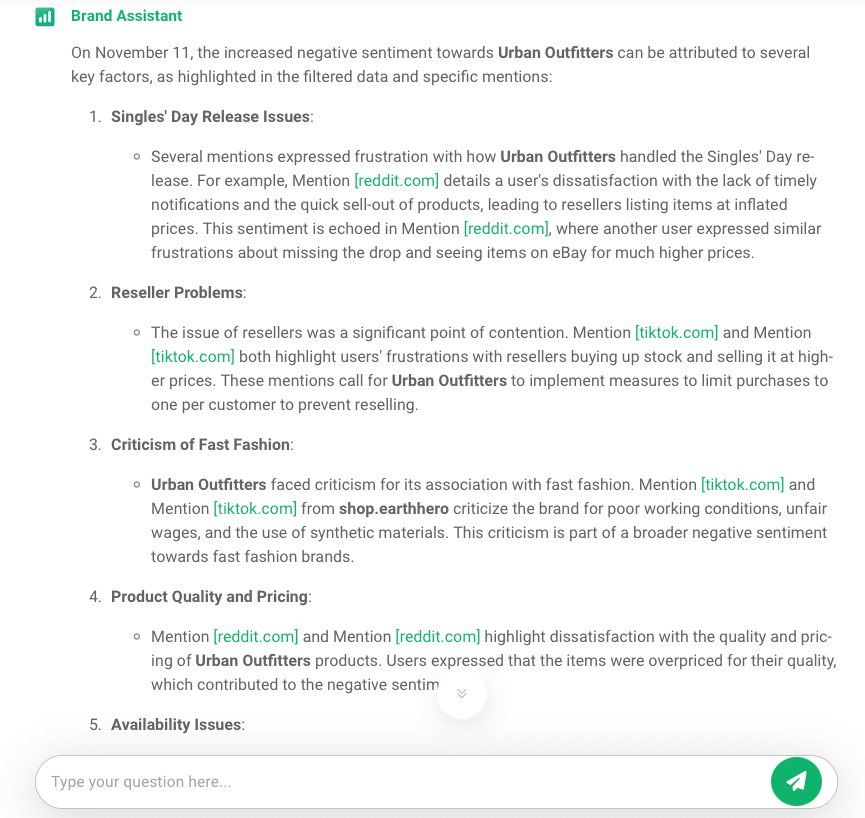
As you can see, the AI Brand Assistant provides a detailed answer with references to particular mentions.
It allows you to quickly get a grasp of your brand performance online and undertake needed action.
How to measure brand sentiment?
There are 5 most common ways of assessing brand sentiment.
Different methods may be the most efficient for you, depending on your business size and goals.
Find out how to measure sentiment for your own brand.
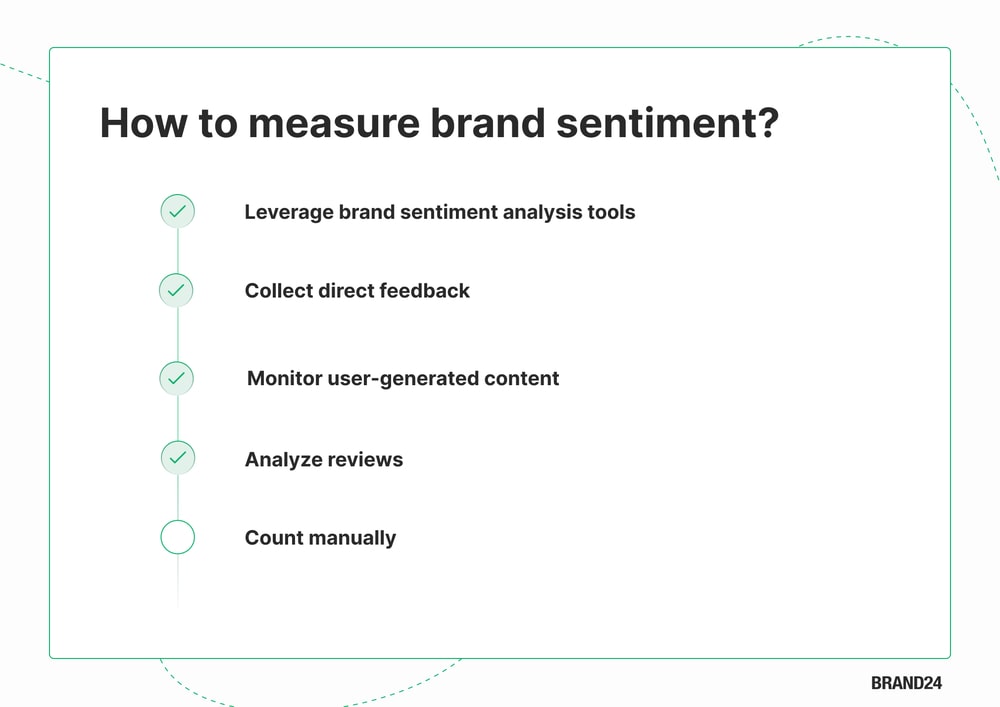
01 Leverage brand sentiment analysis tools
This is the most effective solution for tracking brand sentiment.
Dedicated media monitoring tools will do all the job for you and provide actionable insights on your brand’s performance.
Let’s revisit the Urban Outfitters case now and determine why the negative sentiment peaked on November 11, 2024.
I start by entering my social media monitoring project for Urban Outfitters brand.
The Anomaly Detection feature immediately informs me about an abnormal brand perception online.
The feature detected a peak in the volume of mentions on November 11, 2024.
Next, our AI-powered algorithm analyzed all the brand mentions collected on that day to find a common denominator indicating the topic that boosted social media engagement on that day.

It turns out to be the Singles Day vinyl release.
Now, I will switch to the sentiment analysis chart to check if the buzz was positive or negative.

While the number of positive sentiment is higher than the negative brand mentions volume, the latter is still higher than usual.
That’s why it’s worth examining the issue.
I filtered the negative brand mentions from November 11, and here’s what I found.
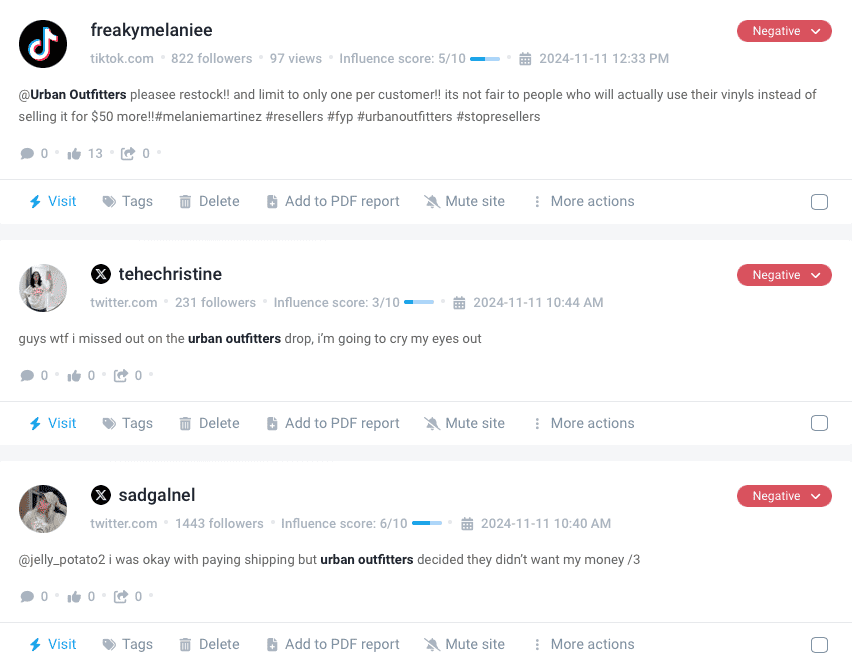
Most negative feelings are about the limited availability of the vinyls.
This is a beneficial insight that Urban Outfitters can use to improve their customer experience.
By addressing the need for more vinyl records, the brand could show that it cares about its consumer feedback and gain more satisfied customers, gaining loyalty in the long term.
02 Collect direct feedback
It is one of the most reliable ways to measure brand sentiment.
But how to collect customer feedback directly?
Consider using surveys, interviews, focus groups, and analyzing online reviews.
These approaches provide valuable, unfiltered insights into how customers perceive your brand, helping to shape your marketing strategies and identify areas for improvement.
Additionally, engaging directly with customers allows you to ask in-depth questions, uncovering what truly matters to them and how you can better meet their needs.
Customer feedback tools can be incredibly helpful to streamline this process.
These tools not only simplify the collection and organization of feedback but also save time and effort in planning and managing your customer engagement initiatives.
03 Monitor UGC
User-generated content is your source of truth regarding your brand perception online.
If users willingly post about you and promote your product, you know you are doing great.
When people post about your brand on their social media, they think your solution is so excellent that they want everyone to learn about it.
Nowadays, UGC has incredible power. It comes across as more authentic than a branded advertisement, which makes it work better to drive sales and interest.
When you discover faithful brand advocates around your business, don’t hesitate to contact them and collaborate.
Especially when an influencer aligns with your brand messaging and values. Collaborating with the right people will multiply the positive feelings around your brand.
You can also monitor UGC and identify your brand advocates with Brand24.

04 Analyze reviews
Reviews are a powerful indicator of brand sentiment, directly reflecting your customers’ experiences.
To stay in tune with their perceptions, continuously monitor reviews on popular review sites and social media channels, ensuring you can swiftly respond to feedback.
Address negative reviews promptly through your customer service team.
A rise in negative mentions can signal that your brand is falling short of customer expectations, making it crucial to prioritize improving brand sentiment by actively listening to and addressing customer concerns.
Conversely, positive feedback is a great sign, but should not go unnoticed. A simple “thank you” or acknowledgment can go a long way in fostering goodwill.
Each positive comment strengthens your brand reputation, so always express appreciation to those who take the time to share their support.
05 Count manually
You can calculate a brand sentiment score by assigning a numerical value to different sentiment categories.
For instance:
- Positive sentiment = +1
- Neutral sentiment = 0
- Negative sentiment = -1
The formula could be:

A positive score indicates an overall positive sentiment, while a negative score suggests the domination of negative reactions.
Unfortunately, this solution might be complicated and time-consuming. Especially if you get dozens of reviews from different social media platforms and review sites.
At the same time, it’s obviously the most cost-effective method.
Thus, it might be a good solution for small businesses and startups that lack a budget for social listening tools.
It may also work out for analyzing your results on a particular review site that groups your reviews into categories according to the sentiment analysis and informs you about the total number in each category.
Otherwise, manually counting the reviews with particular customer sentiment would be an obvious waste of time.
Best practices for good brand sentiment
You already know how to measure brand sentiment. Now, let’s examine the practices you can implement to ensure your brand evokes positive sentiments.
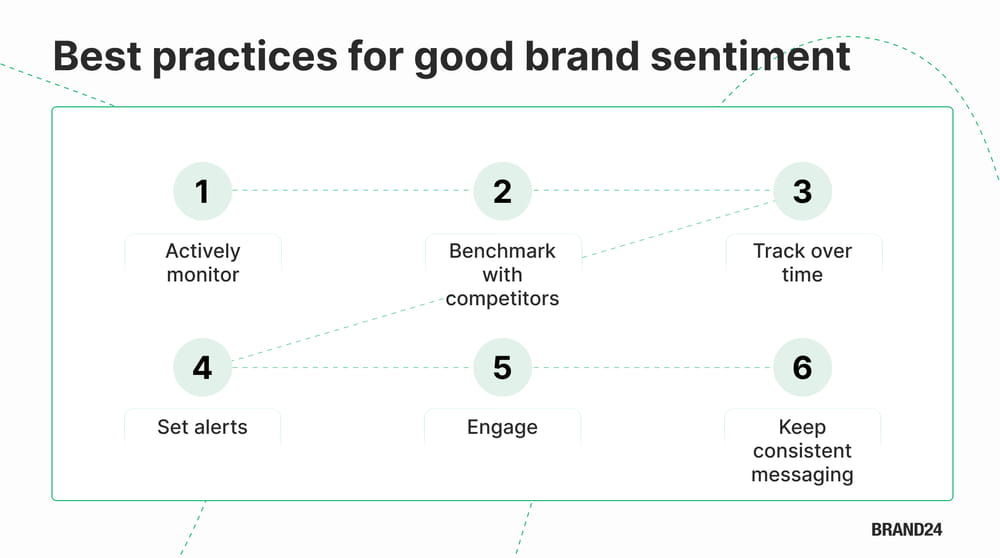
01 Actively monitor
To enhance brand sentiment, actively monitor conversations about your brand.
This involves using social listening tools to scan social media platforms, forums, and review sites for mentions.
By staying informed on customer sentiment, you can quickly identify emerging trends, understand customer pain points, and respond promptly to any negative feedback before it escalates.
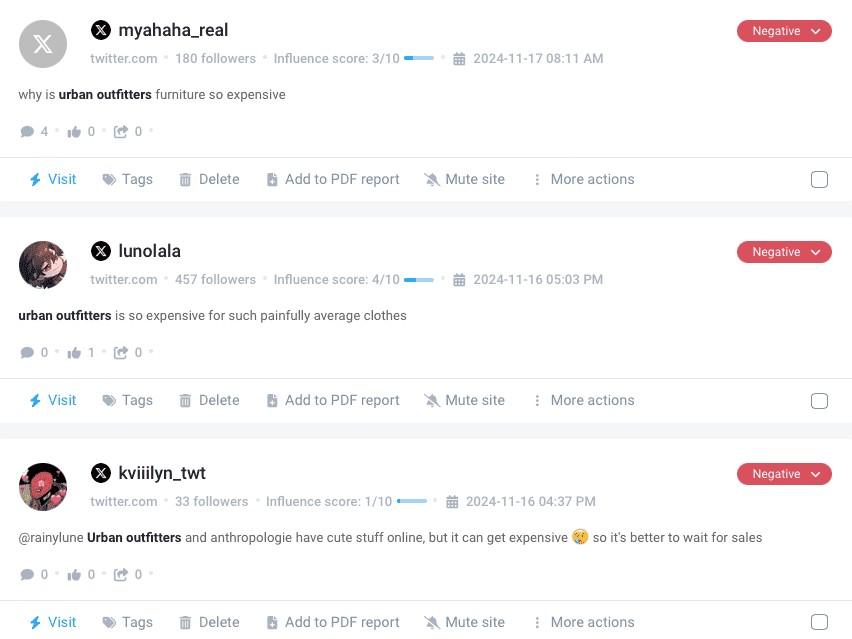
Here, for instance, you can see that many people complain about Urban Outfitter’s high prices.
02 Benchmark with competitors
Comparing your brand’s sentiment with competitors provides context on where you stand in your industry.
Analyzing competitors’ strengths and weaknesses allows you to identify opportunities for differentiation and improvement.
By understanding what customers appreciate in other brands, you can adjust your strategies to better meet their expectations and improve your sentiment.
You can easily benchmark with competitors using Brand24.
Here’s a comparison of Urban Outfitters and two other clothing brands.
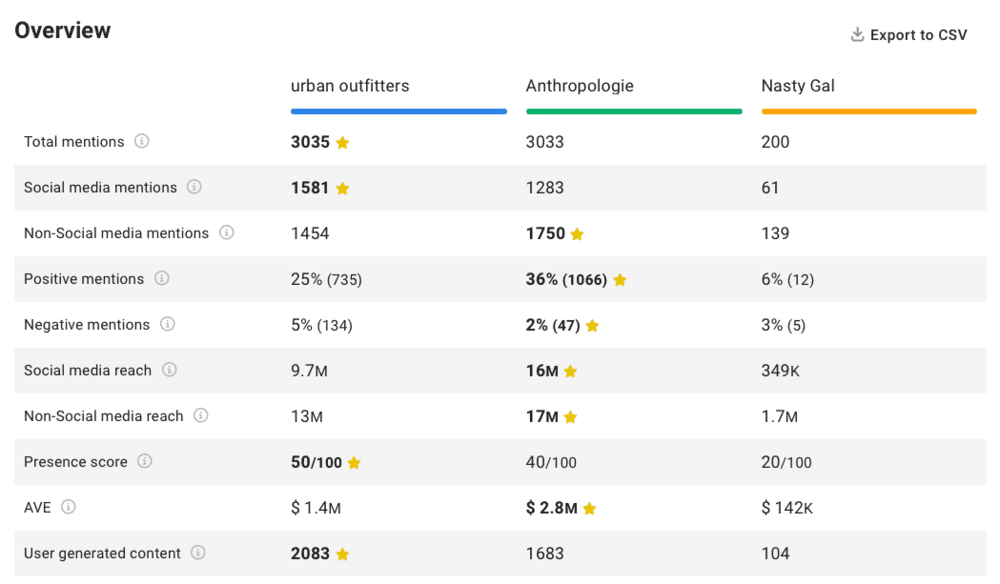
03 Track over time
Brand sentiment is not static; it fluctuates based on marketing campaigns, customer service interactions, product updates, and external factors.
Tracking sentiment over time helps you identify patterns, measure campaign effectiveness, and understand how changes within your company or industry trends affect public perception.
Regular analysis can reveal the long-term impact of your strategies.
Here’s how you can easily compare your metrics in time with Brand24:
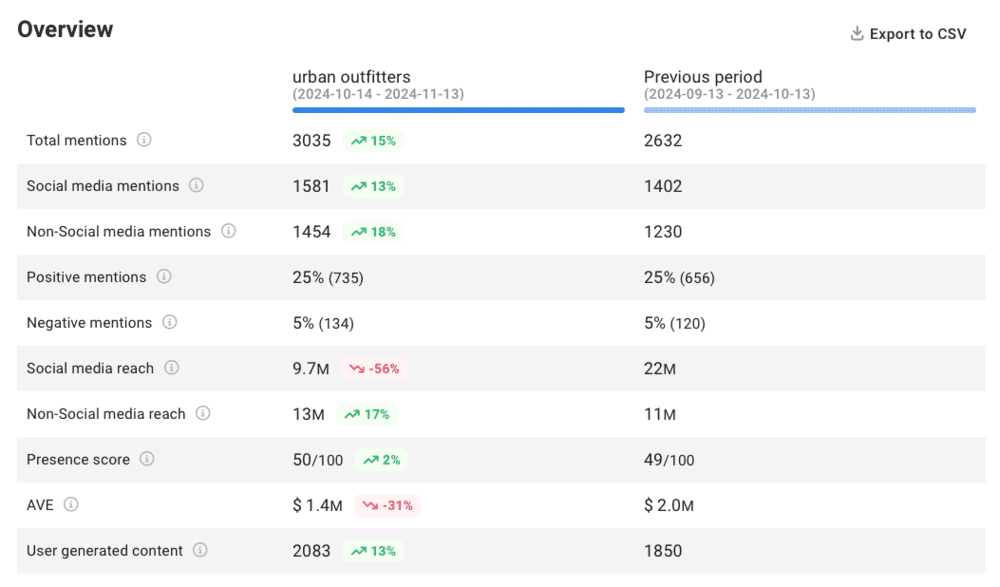
04 Set alerts
Setting up real-time alerts for brand mentions lets your team stay on top of urgent feedback and respond quickly.
Alerts ensure you don’t miss critical conversations, especially during product launches, crises, or trending topics that can quickly affect brand sentiment.
05 Engage
Engaging with your audience is crucial for building and maintaining a positive brand sentiment.
Responding to both positive and negative feedback shows that your brand values customer opinions.
Acknowledge concerns, provide solutions where needed, and express gratitude for positive feedback.
Genuine and timely engagement fosters loyalty and encourages positive word-of-mouth.
06 Keep consistent brand messaging
Consistency in brand messaging is vital to creating a unified perception of your brand.
This means ensuring your brand voice, tone, and values are consistently reflected across all communication channels.
Misaligned messaging can lead to confusion and erode trust, negatively impacting sentiment.
Maintaining a clear and consistent narrative builds a strong, trustworthy brand image that resonates with your target audience.
How to improve brand sentiment?
Positive brand sentiment is fundamental; you already know that.
Now, let’s see what you can do if your brand needs to catch up in customer sentiment.
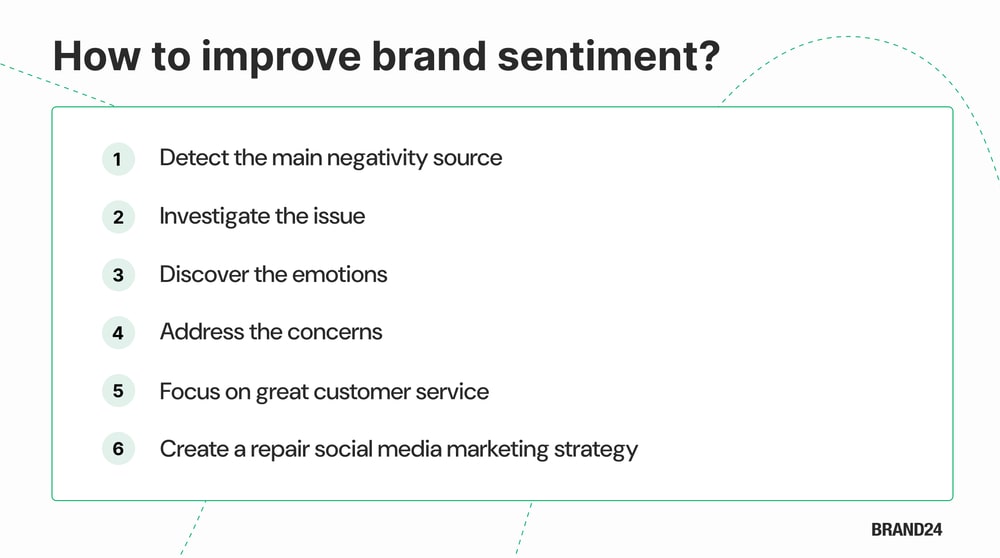
01 Detect the main negativity source
When you see that your brand sentiment is going downhill, you must act fast.
Start by detecting the biggest source of the problem.
Which online source produces the most negative posts and comments about your brand online?
You can easily check that with the help of Brand24.
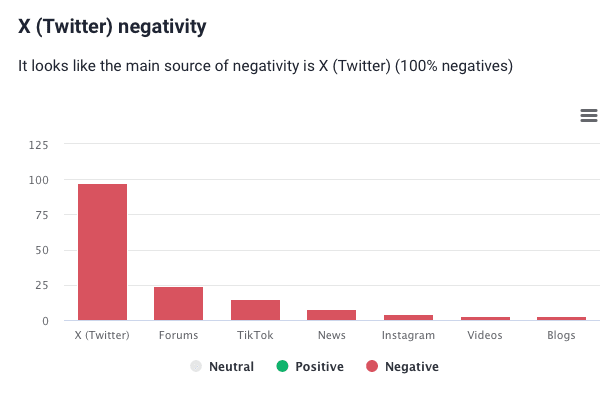
As you can see, for Urban Outfitters, X (Twitter) is the biggest source of negativity.
Thus, the company should first fix the negative mentions on this social platform to achieve a good brand sentiment.
02 Investigate the issue
Now, you know which platform to start on.
It’s time to examine the reason behind the mixed sentiment. Use Topic Analysis in your Brand24 dashboard to detect the main topics that accumulate your audience’s negative mentions.
By analyzing those, you will be able to address the issue more globally, if needed, and implement an online reputation repair strategy quicker.
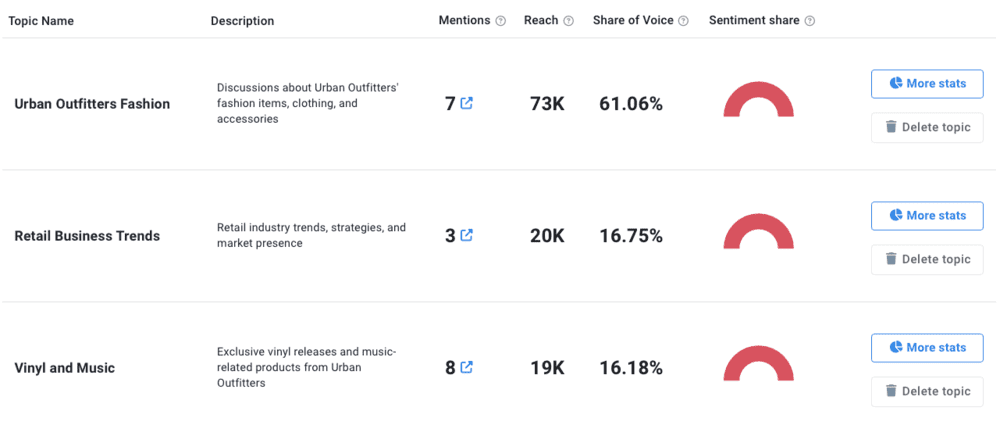
03 Discover the emotions
Sentiment analysis is the fundamental part of analyzing your brand PR performance.
However, it’s good to examine the emotions more closely when you notice negativity.
Here Emotion Analysis comes in to save the day.
Thanks to advanced Machine Learning algorithms, Brand24 recognizes nuanced emotions like disgust, sadness, anger, and fear.
This precise analysis will help you better assess the steps you need to take to improve your brand’s perception and sentiment score.
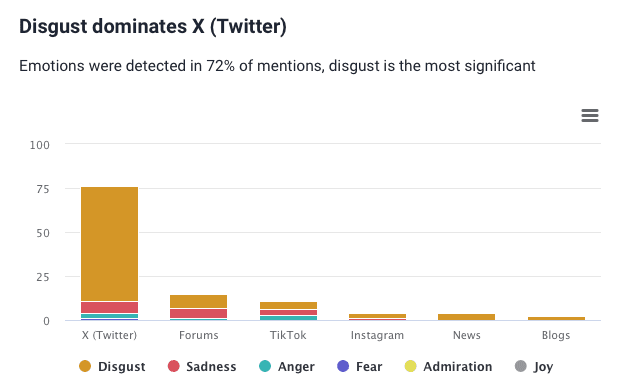
04 Address the concerns
Now that you know enough about the issue, it’s time to act.
Addressing your target audience’s concerns online is essential, but it’s just one thing.
The next step is adjusting your product or strategy to fit your customers’ needs better.
Every negative mention you get is valuable feedback that, if you listen carefully enough, will help you develop your product or service in the right direction.
05 Focus on great customer service
Good customer service is a sure way to keep customers happy.
Thus, if your brand sentiment is at its lowest, ensure you take great care of your customers and show dedication to improvement.
06 Create a repair social media marketing strategy
Crafting a reputation repair strategy on social media can also help with brand sentiment.
For one, it’s a great place for your spokesperson to represent the brand’s values in the best light possible.
Similarly, your social media is the best channel for communicating with your audience when a PR crisis occurs.
But there’s more. Another effective strategy is creating engaging and useful content that will evoke positive sentiments and engagement, balancing out the negativity.
Why is brand sentiment analysis important?
Is brand sentiment important?
I think I’ve already proven it.
Brand sentiment can make or break your company, so monitoring it and tracking how you’re perceived is essential.
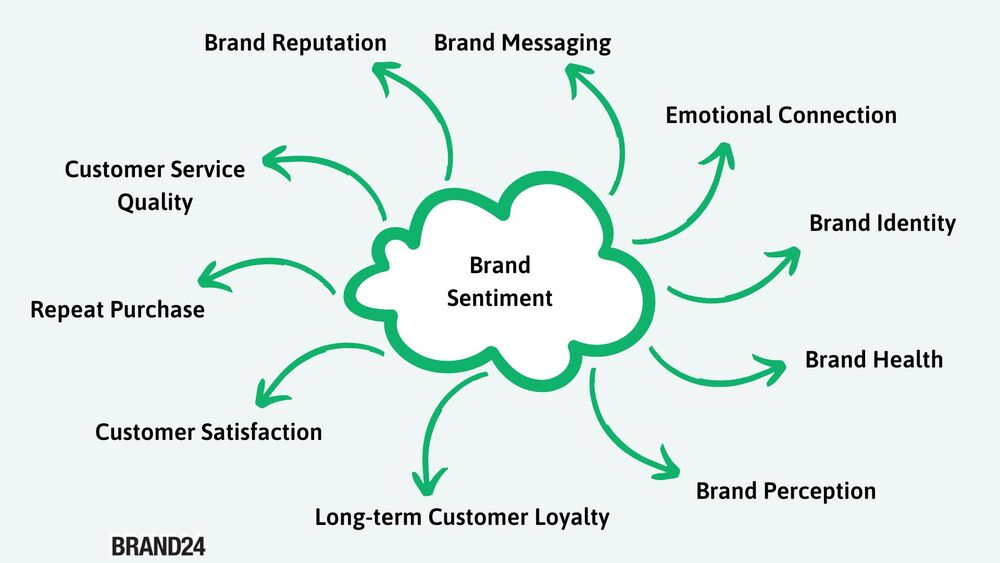
Brand sentiment plays a vital role in shaping customer perceptions and loyalty. It influences purchasing decisions and the overall reputation of the brand.
Positive sentiment fosters trust, strengthens emotional connections, and encourages repeat purchases, leading to long-term loyalty.
In contrast, negative sentiment can drive customers away, causing potential sales losses and detrimental brand impressions.
Since consumers often rely on reviews, social media, and word-of-mouth before making purchase decisions, a brand that maintains positive sentiment is more likely to be chosen over competitors.
Brand sentiment is also related to your brand health and customer satisfaction.
Brand health measures how well a company delivers on particular features of the product or service it promises its customers.
Obviously, this influences customer satisfaction, reflecting how well your brand meets customer expectations.
Conclusion
Brand sentiment is an important indicator of how your brand is perceived in the market.
After reading this article, you know how to check, measure, and improve your brand sentiment.
Remember about active monitoring, benchmarking with competitors, and engaging with your audience to maintain good brand sentiment.
If something goes wrong, consult my tips and leverage online reputation management software like Brand24.
Lastly, don’t forget about my PRO tip!
Leverage AI Brand Assistant for quick and effective business reputation management and streamlined sentiment analysis!
Key takeaway:
- Brand sentiment indicates the attitude of your audience towards your brand. It can be measured through sentiment analysis and is described as positive, negative, or neutral sentiment.
- Specialized brand sentiment tracking tools can help you monitor your sentiment across social media platforms, review sites, and beyond.
- Monitoring brand sentiment helps you adjust your marketing strategy, better communicate brand values, and improve your customers’ experiences.
- Boosting brand sentiment attracts new customers, supports building brand loyalty, and establishes you as the market leader.



